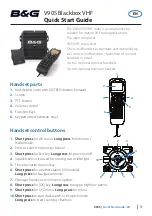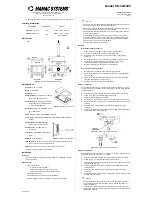
POWER
AMPLIFIER
LOW
BAND
PUB96
‐
28
Rev
2
Aug.
2007
28-4
PA
Module,
•
Remove
all
fuses
from
the
module
to
be
tested.
(There
are
12
fuses
in
total).
•
Adjust
all
bias
pots
to
maximum
resistance,
for
minimum
bias
voltage.
(Again,
there
are
12).
•
Use
a
clip
lead
to
short
the
junction
of
C7,
R6,
R7
and
R10
to
ground.
This
shuts
off
side
B
of
the
amplifier
so
it
will
not
interfere
with
measurement
of
bias
current
from
side
A.
•
Terminate
the
RF
input
and
output
into
a
50
Ω
load.
•
Apply
+50VDC
from
the
front
panel
test
point
on
the
transmitter,
through
an
ammeter,
to
the
positive
copper
bus
bar,
and
its
negative
to
chassis.
Caution:
Observe
polarity!
•
Check
the
voltage
on
the
bias
terminals,
it
should
be
39
V
±2
V.
(The
bias
terminals
are
connected
together
via
insulated
bus
wire).
•
Read
the
current
drawn
by
the
VSWR
board
and
bias
regulator.
Next,
install
a
fuse
in
side
A
(nearest
the
panel)
of
amplifier
#1;
adjust
the
corresponding
bias
pot
for
a
500
mA
increase
in
the
power
supply
current;
this
increase
corresponds
to
an
idling
bias
current
of
0.5
A
(750mA
for
digital
operation).
Remove
the
fuse.
Remove
the
side
B
bias
short
and
place
it
on
side
A
at
the
junction
of
C6,
R2,
R3
and
R9.
Place
the
fuse
in
side
B.
Adjust
the
side
B
bias
pot
for
the
proper
current.
•
Move
the
fuse
to
the
remaining
fuse
holders,
one
at
a
time,
and
adjust
each
companion
bias
potentiometer
in
the
same
manner
for
the
proper
bias
current.
•
Install
remaining
fuses
and
remove
the
bias
short
after
all
bias
adjustments
have
been
made.
Low
power
sweep
of
amplifiers
Note:
Low
power
sweep
of
PA
modules
should
not
be
required
under
normal
circumstances
–
even
when
replacing
FET
devices.
There
are
no
tuning
adjustments
on
these
modules.
•
Ensure
that
terminations
are
in
place
in
the
test
setup.
All
modules
require
50
Ω
source
and
load
impedances
to
prevent
damage
and
for
consistent
results
during
testing.
•
Connect
the
module
to
a
sweep
system,
typically
as
shown
in
Figure
1.
The
sweep
generator
should
be
adjusted
to
give
a
linear
sweep
from
about
45
to
75
MHz,
or
from
65
to
95
MHz,
to
sweep
the
part
of
Low
Band
that
the
module
is
intended
for,
with
a
small
amount
of
out
‐
of
‐
band
signal
on
both
ends.
Ensure
that
a
coaxial
20
dB
attenuator
pad
is
connected
to
the
RF
output
of
the
amplifier,
in
order
to
prevent
possible
damage
to
the
sweep
comparator.
•
Connect
the
lab
power
supply
+50
V
to
the
positive
supply
bus
bar,
and
the
negative
to
the
chassis
of
the
amplifier.
The
current
should
be
limited
to
7
or
8
A
for
this
test.
Caution:
observe
polarity!
•
With
the
power
supply
switched
on,
the
current
drawn
should
be
not
more
than
the
bias
current
for
all
the
devices
together
‐
about
6
amperes
(12
x
0.5
A)
for
the
PA
module.
•
The
swept
in
‐
band
frequency
response,
for
Low
Band
modules,
should
be
essentially
flat
within
±1
dB
as
shown
in
Figure
1,
with
gain
approximately
20
±1
dB.













































